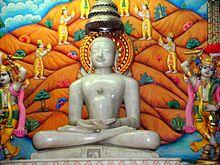Ajitanatha
| Ajitanatha | |
|---|---|
2nd Jain Tirthankara | |
 Ajitanatha (Mathura Chaurasi) | |
| Venerated in | Jainism |
| Predecessor | Rishabhanatha |
| Successor | Sambhavanatha |
| Symbol | Elephant |
| Height | 450 bows |
| Age | 72 lakh purvas (508.032 x 1018 years old) |
| Color | Golden |
| Genealogy | |
| Born | |
| Died | |
| Parents |
|
| Part of a series on |
| Jainism |
|---|
 |
Ajitanath (lit. invincible) was the second tirthankara of the present age, avasarpini (half time cycle) according to Jainism. He was born to King Jitashatru and Queen Vijaya at Ayodhya in the Ikshvaku dynasty. He was a liberated soul which has destroyed all of its karma.
Life
Ajitnatha (lit. invincible)[1] was the second tirthankara of the present age, avasarpini (half time cycle) according to Jainism.[2]
Ajitnatha was born in the town of Saketa to King Jitashatru and Queen Vijaya at Ayodhya in the Ikshvaku dynasty on magha-shukla-dashmi (the tenth day of the bright half of the month of Magha).[2] His height was 450 dhanusha. He lived for a span of 72 lakh purva.[1]
He attained kevala jnana under the sal tree and Moksha on chaitra-shukla-panchmi (fifth day of the bright half of the month of Chaitra) from Shikharji.[3][1]
Simhasena was his chief Ganadhara.[1]
Literature
The Yajurveda mentions the name of Ajitanatha, but the meaning is not clear. According to Jain traditions, his younger brother was Sagara. Sagara, who became the second Chakravartin, is known from the traditions of both Hindu and Jain scriptures.[4]
Adoration
Ajinatha is associated with his Elephant emblem, Saptha-parna tree, Mahayaksha Yaksha and Yogini & Ajithabala Yakshis.[5]
Literature
- The Ajitha purana, by Ranna narrates the story of Ajitanatha.
- Ajitasanti compiled by Nandisena in 7th century is a praise to Ajitnatha and Shantinatha.[6]
Famous temples
- Taranga Jain Temple, Vasai Jain Temple in Bhadresar, Bandhaji[citation needed]
- Chaturmukha Basadi, Gerusoppa
See also
References
Citations
- ^ a b c d Vijay K. Jain 2015, p. 183.
- ^ a b Tukol 1980, p. 31.
- ^ Krishna & Amirthalingam 2014, p. 46.
- ^ Jain, Kailash Chandra, Antiquity of Jainism, Jainism Literature Center
- ^ Tandon 2002, p. 44.
- ^ Cort 2001, p. 236.
Sources
- Jain, Vijay K. (2015), Acarya Samantabhadra's Svayambhustotra: Adoration of The Twenty-four Tirthankara, Vikalp Printers, ISBN 978-81-903639-7-6, archived from the original on 16 September 2015,
 This article incorporates text from this source, which is in the public domain.
This article incorporates text from this source, which is in the public domain. - Krishna, Nanditha; Amirthalingam, M. (2014) [2013], Sacred Plants of India, Penguin Books, ISBN 978-9-351-18691-5
- Tandon, Om Prakash (2002) [1968], Jaina Shrines in India (1 ed.), New Delhi: Publications Division, Ministry of Information and Broadcasting, Government of India, ISBN 81-230-1013-3
- Tukol, T. K. (1980), Compendium of Jainism, Dharwad: University of Karnataka



